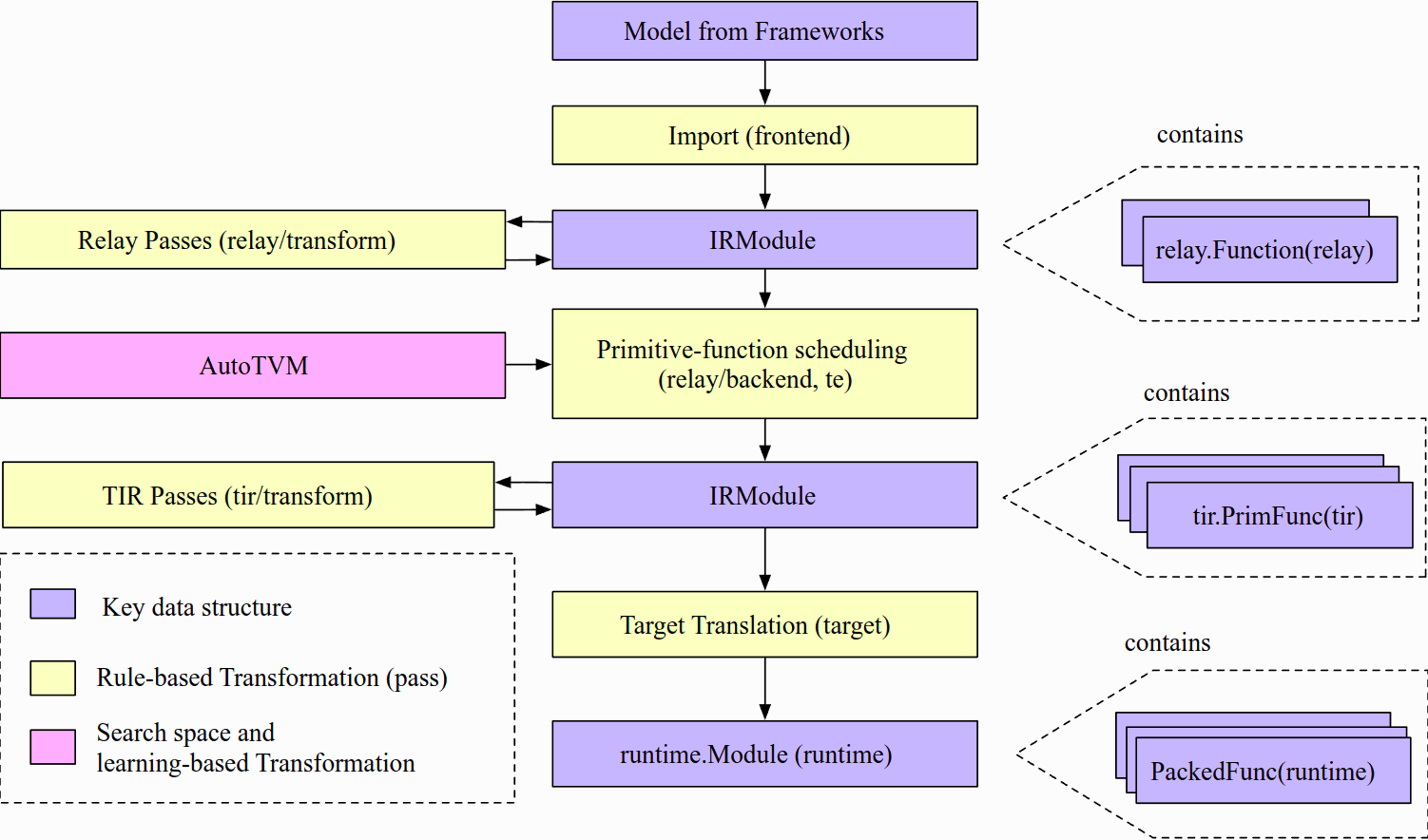TVM 是一个开源深度学习编译器,可适用于各类 CPUs, GPUs 及其他专用加速器。它的目标是使得我们能够在任何硬件上优化和运行自己的模型。不同于深度学习框架关注模型生产力,TVM 更关注模型在硬件上的性能和效率。
本文只简单介绍 TVM 的编译流程,及如何自动调优自己的模型。更深入了解,可见 TVM 官方内容:
编译流程
TVM 文档 Design and Architecture 讲述了实例编译流程、逻辑结构组件、设备目标实现等。其中流程见下图:

从高层次上看,包含了如下步骤:
- 导入(Import):前端组件将模型提取进 IRModule,其是模型内部表示(IR)的函数集合。
- 转换(Transformation):编译器将 IRModule 转换为另一个功能等效或近似等效(如量化情况下)的 IRModule。大多转换都是独立于目标(后端)的。TVM 也允许目标影响转换通道的配置。
- 目标翻译(Target Translation):编译器翻译(代码生成) IRModule 到目标上的可执行格式。目标翻译结果被封装为 runtime.Module,可以在目标运行时环境中导出、加载和执行。
- 运行时执行(Runtime Execution):用户加载一个 runtime.Module 并在支持的运行时环境中运行编译好的函数。
调优模型
TVM 文档 User Tutorial 从怎么编译优化模型开始,逐步深入到 TE, TensorIR, Relay 等更底层的逻辑结构组件。
这里只讲下如何用 AutoTVM 自动调优模型,实际了解 TVM 编译、调优、运行模型的过程。原文见 Compiling and Optimizing a Model with the Python Interface (AutoTVM)。
准备 TVM
首先,安装 TVM。可见文档 Installing TVM,或笔记「TVM 安装」。
之后,即可通过 TVM Python API 来调优模型。我们先导入如下依赖:
import onnx
from tvm.contrib.download import download_testdata
from PIL import Image
import numpy as np
import tvm.relay as relay
import tvm
from tvm.contrib import graph_executor准备模型,并加载
获取预训练的 ResNet-50 v2 ONNX 模型,并加载:
model_url = "".join(
[
"https://github.com/onnx/models/raw/",
"main/vision/classification/resnet/model/",
"resnet50-v2-7.onnx",
]
)
model_path = download_testdata(model_url, "resnet50-v2-7.onnx", module="onnx")
onnx_model = onnx.load(model_path)准备图片,并前处理
获取一张测试图片,并前处理成 224x224 NCHW 格式:
img_url = "https://s3.amazonaws.com/model-server/inputs/kitten.jpg"
img_path = download_testdata(img_url, "imagenet_cat.png", module="data")
# Resize it to 224x224
resized_image = Image.open(img_path).resize((224, 224))
img_data = np.asarray(resized_image).astype("float32")
# Our input image is in HWC layout while ONNX expects CHW input, so convert the array
img_data = np.transpose(img_data, (2, 0, 1))
# Normalize according to the ImageNet input specification
imagenet_mean = np.array([0.485, 0.456, 0.406]).reshape((3, 1, 1))
imagenet_stddev = np.array([0.229, 0.224, 0.225]).reshape((3, 1, 1))
norm_img_data = (img_data / 255 - imagenet_mean) / imagenet_stddev
# Add the batch dimension, as we are expecting 4-dimensional input: NCHW.
img_data = np.expand_dims(norm_img_data, axis=0)编译模型,用 TVM Relay
TVM 导入 ONNX 模型成 Relay,并创建 TVM 图模型:
target = input("target [llvm]: ")
if not target:
target = "llvm"
# target = "llvm -mcpu=core-avx2"
# target = "llvm -mcpu=skylake-avx512"
# The input name may vary across model types. You can use a tool
# like Netron to check input names
input_name = "data"
shape_dict = {input_name: img_data.shape}
mod, params = relay.frontend.from_onnx(onnx_model, shape_dict)
with tvm.transform.PassContext(opt_level=3):
lib = relay.build(mod, target=target, params=params)
dev = tvm.device(str(target), 0)
module = graph_executor.GraphModule(lib["default"](dev))其中 target 是目标硬件平台。llvm 指用 CPU,建议指明架构指令集,可更优化性能。如下命令可查看 CPU:
$ llc --version | grep CPU
Host CPU: skylake
$ lscpu或直接上厂商网站(如 Intel® Products)查看产品参数。
运行模型,用 TVM Runtime
用 TVM Runtime 运行模型,进行预测:
dtype = "float32"
module.set_input(input_name, img_data)
module.run()
output_shape = (1, 1000)
tvm_output = module.get_output(0, tvm.nd.empty(output_shape)).numpy()收集优化前的性能数据
收集优化前的性能数据:
import timeit
timing_number = 10
timing_repeat = 10
unoptimized = (
np.array(timeit.Timer(lambda: module.run()).repeat(repeat=timing_repeat, number=timing_number))
* 1000
/ timing_number
)
unoptimized = {
"mean": np.mean(unoptimized),
"median": np.median(unoptimized),
"std": np.std(unoptimized),
}
print(unoptimized)之后,用以对比优化后的性能。
后处理输出,得知预测结果
输出的预测结果,后处理成可读的分类结果:
from scipy.special import softmax
# Download a list of labels
labels_url = "https://s3.amazonaws.com/onnx-model-zoo/synset.txt"
labels_path = download_testdata(labels_url, "synset.txt", module="data")
with open(labels_path, "r") as f:
labels = [l.rstrip() for l in f]
# Open the output and read the output tensor
scores = softmax(tvm_output)
scores = np.squeeze(scores)
ranks = np.argsort(scores)[::-1]
for rank in ranks[0:5]:
print("class='%s' with probability=%f" % (labels[rank], scores[rank]))调优模型,获取调优数据
于目标硬件平台,用 AutoTVM 自动调优,获取调优数据:
import tvm.auto_scheduler as auto_scheduler
from tvm.autotvm.tuner import XGBTuner
from tvm import autotvm
number = 10
repeat = 1
min_repeat_ms = 0 # since we're tuning on a CPU, can be set to 0
timeout = 10 # in seconds
# create a TVM runner
runner = autotvm.LocalRunner(
number=number,
repeat=repeat,
timeout=timeout,
min_repeat_ms=min_repeat_ms,
enable_cpu_cache_flush=True,
)
tuning_option = {
"tuner": "xgb",
"trials": 10,
"early_stopping": 100,
"measure_option": autotvm.measure_option(
builder=autotvm.LocalBuilder(build_func="default"), runner=runner
),
"tuning_records": "resnet-50-v2-autotuning.json",
}
# begin by extracting the tasks from the onnx model
tasks = autotvm.task.extract_from_program(mod["main"], target=target, params=params)
# Tune the extracted tasks sequentially.
for i, task in enumerate(tasks):
prefix = "[Task %2d/%2d] " % (i + 1, len(tasks))
tuner_obj = XGBTuner(task, loss_type="rank")
tuner_obj.tune(
n_trial=min(tuning_option["trials"], len(task.config_space)),
early_stopping=tuning_option["early_stopping"],
measure_option=tuning_option["measure_option"],
callbacks=[
autotvm.callback.progress_bar(tuning_option["trials"], prefix=prefix),
autotvm.callback.log_to_file(tuning_option["tuning_records"]),
],
)上述 tuning_option 选用的 XGBoost Grid 算法进行优化搜索,数据记录进 tuning_records。
重编译模型,用调优数据
重新编译出一个优化模型,依据调优数据:
with autotvm.apply_history_best(tuning_option["tuning_records"]):
with tvm.transform.PassContext(opt_level=3, config={}):
lib = relay.build(mod, target=target, params=params)
dev = tvm.device(str(target), 0)
module = graph_executor.GraphModule(lib["default"](dev))
# Verify that the optimized model runs and produces the same results
dtype = "float32"
module.set_input(input_name, img_data)
module.run()
output_shape = (1, 1000)
tvm_output = module.get_output(0, tvm.nd.empty(output_shape)).numpy()
scores = softmax(tvm_output)
scores = np.squeeze(scores)
ranks = np.argsort(scores)[::-1]
for rank in ranks[0:5]:
print("class='%s' with probability=%f" % (labels[rank], scores[rank]))对比调优与非调优模型
收集优化后的性能数据,与优化前的对比:
import timeit
timing_number = 10
timing_repeat = 10
optimized = (
np.array(timeit.Timer(lambda: module.run()).repeat(repeat=timing_repeat, number=timing_number))
* 1000
/ timing_number
)
optimized = {"mean": np.mean(optimized), "median": np.median(optimized), "std": np.std(optimized)}
print("optimized: %s" % (optimized))
print("unoptimized: %s" % (unoptimized))调优模型,整个过程的运行结果,如下:
$ time python autotvm_tune.py
# TVM 编译运行模型
## Downloading and Loading the ONNX Model
## Downloading, Preprocessing, and Loading the Test Image
## Compile the Model With Relay
target [llvm]: llvm -mcpu=core-avx2
One or more operators have not been tuned. Please tune your model for better performance. Use DEBUG logging level to see more details.
## Execute on the TVM Runtime
## Collect Basic Performance Data
{'mean': 44.97057118016528, 'median': 42.52320024970686, 'std': 6.870915251002107}
## Postprocess the output
class='n02123045 tabby, tabby cat' with probability=0.621104
class='n02123159 tiger cat' with probability=0.356378
class='n02124075 Egyptian cat' with probability=0.019712
class='n02129604 tiger, Panthera tigris' with probability=0.001215
class='n04040759 radiator' with probability=0.000262
# AutoTVM 调优模型 [Y/n]
## Tune the model
[Task 1/25] Current/Best: 156.96/ 353.76 GFLOPS | Progress: (10/10) | 4.78 s Done.
[Task 2/25] Current/Best: 54.66/ 241.25 GFLOPS | Progress: (10/10) | 2.88 s Done.
[Task 3/25] Current/Best: 116.71/ 241.30 GFLOPS | Progress: (10/10) | 3.48 s Done.
[Task 4/25] Current/Best: 119.92/ 184.18 GFLOPS | Progress: (10/10) | 3.48 s Done.
[Task 5/25] Current/Best: 48.92/ 158.38 GFLOPS | Progress: (10/10) | 3.13 s Done.
[Task 6/25] Current/Best: 156.89/ 230.95 GFLOPS | Progress: (10/10) | 2.82 s Done.
[Task 7/25] Current/Best: 92.33/ 241.99 GFLOPS | Progress: (10/10) | 2.40 s Done.
[Task 8/25] Current/Best: 50.04/ 331.82 GFLOPS | Progress: (10/10) | 2.64 s Done.
[Task 9/25] Current/Best: 188.47/ 409.93 GFLOPS | Progress: (10/10) | 4.44 s Done.
[Task 10/25] Current/Best: 44.81/ 181.67 GFLOPS | Progress: (10/10) | 2.32 s Done.
[Task 11/25] Current/Best: 83.74/ 312.66 GFLOPS | Progress: (10/10) | 2.74 s Done.
[Task 12/25] Current/Best: 96.48/ 294.40 GFLOPS | Progress: (10/10) | 2.82 s Done.
[Task 13/25] Current/Best: 123.74/ 354.34 GFLOPS | Progress: (10/10) | 2.62 s Done.
[Task 14/25] Current/Best: 23.76/ 178.71 GFLOPS | Progress: (10/10) | 2.90 s Done.
[Task 15/25] Current/Best: 119.18/ 534.63 GFLOPS | Progress: (10/10) | 2.49 s Done.
[Task 16/25] Current/Best: 101.24/ 172.92 GFLOPS | Progress: (10/10) | 2.49 s Done.
[Task 17/25] Current/Best: 309.85/ 309.85 GFLOPS | Progress: (10/10) | 2.69 s Done.
[Task 18/25] Current/Best: 54.45/ 368.31 GFLOPS | Progress: (10/10) | 2.46 s Done.
[Task 19/25] Current/Best: 78.69/ 162.43 GFLOPS | Progress: (10/10) | 3.29 s Done.
[Task 20/25] Current/Best: 40.78/ 317.50 GFLOPS | Progress: (10/10) | 4.52 s Done.
[Task 21/25] Current/Best: 169.03/ 296.36 GFLOPS | Progress: (10/10) | 3.95 s Done.
[Task 22/25] Current/Best: 90.96/ 210.43 GFLOPS | Progress: (10/10) | 2.28 s Done.
[Task 23/25] Current/Best: 48.93/ 217.36 GFLOPS | Progress: (10/10) | 2.87 s Done.
[Task 25/25] Current/Best: 0.00/ 0.00 GFLOPS | Progress: (0/10) | 0.00 s Done.
[Task 25/25] Current/Best: 25.50/ 33.86 GFLOPS | Progress: (10/10) | 9.28 s Done.
## Compiling an Optimized Model with Tuning Data
class='n02123045 tabby, tabby cat' with probability=0.621104
class='n02123159 tiger cat' with probability=0.356378
class='n02124075 Egyptian cat' with probability=0.019712
class='n02129604 tiger, Panthera tigris' with probability=0.001215
class='n04040759 radiator' with probability=0.000262
## Comparing the Tuned and Untuned Models
optimized: {'mean': 34.736288779822644, 'median': 34.547542000655085, 'std': 0.5144378649382363}
unoptimized: {'mean': 44.97057118016528, 'median': 42.52320024970686, 'std': 6.870915251002107}
real 3m23.904s
user 5m2.900s
sys 5m37.099s对比性能数据,可以发现:调优模型的运行速度更快、更平稳。
参考
- 笔记: start-ai-compiler
- 资料:
GoCoding 个人实践的经验分享,可关注公众号!













